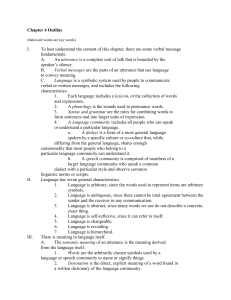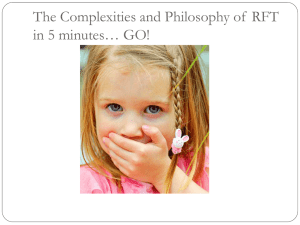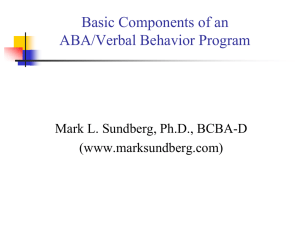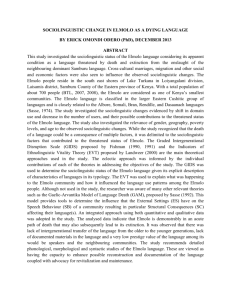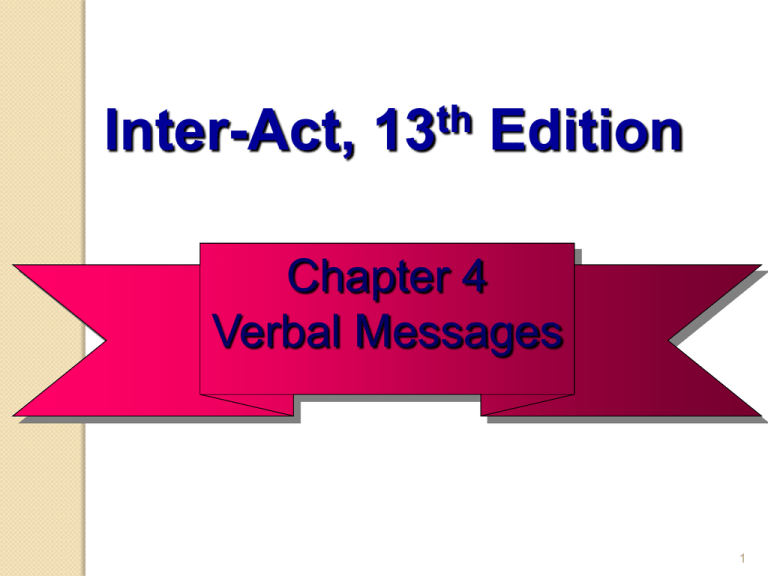
Inter-Act,
th
13
Edition
Chapter 4
Verbal Messages
1
Chapter 4 Learning Objectives
The verbal parts of a message
The characteristics of language
How the meaning of a verbal message in
conveyed and understood
2
Verbal Fundamentals
Utterance
◦ A complete unit of talk that is bounded by the
speaker’s silence
Verbal messages
◦ The parts of an utterance that use language to
convey meaning
Language
◦ A symbolic system used by people to communicate
verbal or written messages, including:
Lexicon (words)
Phonology (sounds)
Grammar & Syntax (rules)
3
Language Community
Language community: group of people who
share a common language or collections of
dialects.
Dialect: form of the language spoken by a
specific culture or co-culture, understood
by the larger language community
Speech community: speak a common
dialect, particular style, observe common
linguistic norms or scripts
Idiolect: our personal vocabularies,
pronunciations and grammar and syntax
when talking or writing
4
Characteristics of Language
Arbitrary
Ambiguous
Abstract
Self-reflective
Changeable
Revealing
Hierarchical
*Thus, language is by nature an imprecise vehicle for
transferring meaning
5
Meaning in the Language
Semantic meaning – the meaning derived from
the language itself
•Words – symbols used by a speech
community to identify things and make
statements about them
• Denotation: direct, explicit meaning of a word
• Connotation: feelings or evaluations we
personally associate with a word
*The size and accuracy of our vocabulary limit our ability to
express what we are thinking and feeling as well as our ability to
understand*
6
Improving Message Semantics
1.
2.
3.
4.
5.
Use specific, concrete, & precise language.
Date information to specify when true.
Index to qualify generalizations.
Adapt language to your listeners.
Demonstrate linguistic sensitivity.
7
Examples:
The senator brought several things to the
meeting….The senator brought recent letters from
her constituency to the meeting. (Precise)
Cancun is really popular with the college
crowd…When we were in Cancun two years ago, it
was really popular with the college crowd. (Dated)
Men are stronger than women…Most men are
stronger than most women. (Indexed)
Now your turn…. Think of some more examples…
Turn to your classmate and share your example!
8
Abstract to Concrete
Art
abstract
Painting
Oil Painting
Impressionist Oil Painting
Renoir’s La Promenade
concrete
9
Rephrase each statement so that it is
less abstract and more concrete:
Edward always finds something critical to say.
Most people have lost any sense of personal
responsibility.
Let’s keep our trip from getting too expensive.
Politicians are dishonest.
10
Dating Information
Specify a time that indicates when a given
fact was true or known to be true:
Palm Springs is really popular with the college
crowd.
When we were in Palm Springs two years ago, it
was really popular with the college crowd.
11
Indexing Generalizations
Mentally or verbally account for individual
differences:
Because men are stronger than
women, Max is stronger than Barbara.
In general, men are stronger than women,
so Max is probably stronger than Barbara.
12
Adapt Language to Listener
Use vocabulary the listener understands.
Use jargon sparingly.
Use slang appropriately .
13
Linguistic Sensitivity
Monitor your language to avoid:
◦ Language that offends or alienates
◦ Pointing out a person’s race, sex, etc.
(nonparallel language)
◦ Prejudicial language
Use inclusive language.
14
Avoid
“Generic” Man
Inclusive language
Policeman
Police officer
Man-made
Synthetic
All of mankind
All the people in the
world
15
How would you change the following terms to avoid sexism?
Fireman
Waitress
Repairman
Stewardess
Mailman
Chairman
Cleaning lady
Congressman
Anchorman
Freshman
16
Verbal Meaning within Conversations
Pragmatic meaning: meaning that arises from
understanding the practical consequences of the
utterance
Speech act: verbal message that implies how the
listener should respond
Cooperative principle: conversational partners
are able to understand meaning because they
assume their partners are collaborating
17
Conversation Guidelines to Improve Pragmatic
Understanding
Quality maxim: Tell the truth, the whole truth, and only the
truth. (Ex: How do I look?)
Quantity maxim: Provide the “right” amount of information.
(Ex: What kind of bread to you want?)
Relevancy maxim: Relate what you say to the topic being
discussed. (Did you study?)
Manner maxim: Be orderly in what you say.
Acknowledge a violation. (I don’t know if this is true..)
Rely on cooperation when interpreting violations. (That will
happen…)
18
Meaning within the Social/Cultural Context
Sociolinguistic meaning: varies in meaning
according to norms and expectations of a
particular co-culture
Idioms: expressions used by members of a
language or speech community whose
meaning differs from the usual meanings in
that combination of words:
“The gas I bought today cost an arm and a leg!”
19
Direct Verbal Style
Indirect Verbal Style
• Openly states the
speaker’s intention
• Straightforward,
unambiguous
• Low-context
cultures
• Masks the speaker’s
true intention
• Roundabout, vague
message
• High-context
cultures
Verbal Styles
20
Improving Sociolinguistic Understanding
Develop intercultural competence.
Practice mindfulness, the process of drawing
novel distinctions.
Recognize, respect, and adapt to the
sociolinguistic practices of others.
21
Homework:
How can you improve your ability to use
language in producing or interpreting the
meaning of verbal messages? Identify a
problem you have forming or understanding
verbal messages. Review the guidelines for
improving the semantic, pragmatic, and
sociolinguistic meaning of verbal messages.
Select at least one of these as a goal.Then
using the interpersonal communication skills
you have studied in the course, write an
improvement plan, including specific
procedures and a way of assessing whether
you’ve reached your goal. Don’t forget to
review your assignment rubric!!!
22


